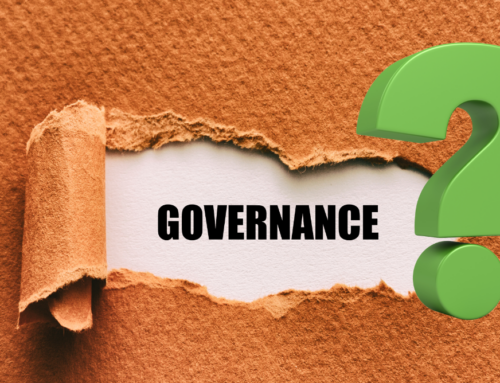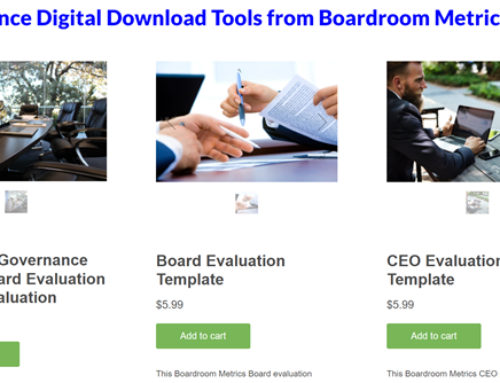Every Board Evaluation should assess Board Meeting effectiveness
The role of a governance Board is oversight of the organization. There are many Board processes for executing the oversight role. The most common Board process is the Board meeting, where Directors get together to discuss risk, strategy and the performance of the organization.
The effectiveness of Board meetings should be part of every Board evaluation. Board meeting evaluations can also occur as a separate governance effectiveness exercise. Here’s what to expect from a Board meeting evaluation:
1. An overall assessment of how well the Board understands its governance role.
Based on the Board meeting agenda and the discussion and decision making that occurs during a meeting, the Board meeting evaluation helps to identify how well the Board understands its governance oversight role. For example, if the meeting is filled with operating reports and discussion of operating issues (very common) then the Board is likely struggling with its governance focus. It is common in a Board meeting evaluation to assess what the Board discusses; define the relevance from a governance perspective; and, measure how much time is devoted to each discussion. The finding here are frequently eye-opening.
2. An assessment of the Board meeting agenda and opportunities for the Board to remain focused on governance-related items.
Re-aligning the Board meeting agenda to ensure governance focus is a very common opportunity that almost all Boards have. Too often, Board meeting agendas are both repetitive (little change from year to year) and filled with items where the governance relevance is unclear. Sometimes, those items need to be removed. They are not relevant governance priorities. However, it is often a case of better organizing the Board meeting agenda, making it clearer to everyone why agenda items are relevant from a governance perspective.
3. An assessment of the meeting leadership provided by the Board Chair.
Well run and effective meetings depend on the leadership ability of the Board Chair. Chairs who are uncertain of corporate governance will permit the Board to stray from its governance role. Failure by the Chair to enforce agenda item timing, will result in drawn out meetings that test the Board’s patience. Inability of the Board Chair to facilitate decisions will result in a Board that is ineffective and weak. In the Board meeting evaluation the Chair is evaluated based on these leadership traits including the ability to understand governance, encourage discussion, manage time and make and follow up on decisions effectively.
4. An assessment of Director preparation and meeting performance.
This includes an assessment of the materials that Directors receive, when they receive them and whether they have taken the time to review the material and readiness for discussion and decision making at the meeting. Board meeting evaluations generally do not include assessments of individual Directors. However, where some or all of the Directors are clearly struggling this will be identified.
5. An assessment of the tools the Board uses to communicate, present, facilitate discussions and communicate both in-person and virtually.
These communication tools are vital for a Board to be effective. Poor technology in particular can seriously hobble a Board’s ability to communicate, understand and make decisions. The quality of simple tools like white Boards and marker pens are often overlooked with respect to meeting effectiveness.
How the Board Meeting Evaluation is Conducted
To evaluate a Board meeting, the auditor (consultant) attends a full Board meeting. With Covid19, this attendance is always virtual. There is some advanced preparation. This includes receiving and reviewing the same materials that a Director receives. In addition, a standard board meeting evaluation checklist is customized based on discussion with the audit sponsor (often the Governance Committee). This helps ensure the unique characteristics of the organization/Board and the needs of the sponsor are recognized and/or included in the Board meeting evaluation. Generally, the auditor is not a participant in the meeting. This can be challenging at times if the Board turns to the auditor/consultant during the Board meeting for their governance expertise (there is sometimes a temptation to bring the auditor into meeting discussions). At the end of the Board meeting, it is common for the auditor to make some observations to the Board. However, the most important feedback – the audit results – are compiled in a report after the meeting that goes to the sponsor for discussion and follow-up.
Benefits of a Board Meeting Evaluation
Regular Board meeting evaluation is an effective, cost efficient method for monitoring the Board’s governance effectiveness. Most of the Board’s governance work occurs in a Board meeting. So, generally there is a high correlation between Board meeting effectiveness and Governance effectiveness. Opportunities identified to improve Board meeting effectiveness will be directly linked to opportunities for improving governance effectiveness, for example, better Chair leadership; more time devoted to strategy; more clarity around performance of the CEO.
Boardroom Metrics Board Meeting Audit Process
Boardroom Metrics conducts Board meeting evaluations on behalf of public, private and not-for-profit clients. For more information on the Boardroom Metrics Board meeting audit process email [email protected] or call 416-994-6552.








Leave A Comment